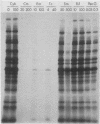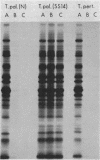Abstract
We have previously demonstrated that cells of Treponema pallidum freshly extracted from infected rabbit testes can be intrinsically radiolabeled with [35 S]methionine to very high specific activities. In this study we used the inhibition of [35 S]methionine incorporation into trichloroacetic acid-precipitable protein in vitro as an assay to test the susceptibilities of three different pathogenic treponemal strains to various antibiotics. In general, the results correlated very well with the known efficacies of these antibiotics in treating human patients with syphilis. One of the strains tested, however, a clinical isolate of T. pallidum designated street strain 14, was found to exhibit high-level resistance to erythromycin and a closely related macrolide, roxithromycin (RU 965). Street strain 14 was originally isolated from a human patient with active secondary syphilis who failed to respond to erythromycin therapy. Thus, our results indicate that an erythromycin-resistant strain of T. pallidum can be responsible for erythromycin treatment failure. In addition, street strain 14 treponemes were found to be generally less susceptible by this assay to a variety of antibiotics than were treponemes of the T. pallidum Nichols strain. These findings suggest that the outer envelope of street strain 14 treponemes may be generally less permeable to antibiotics than is that of Nichols strain treponemes.
Full text
PDF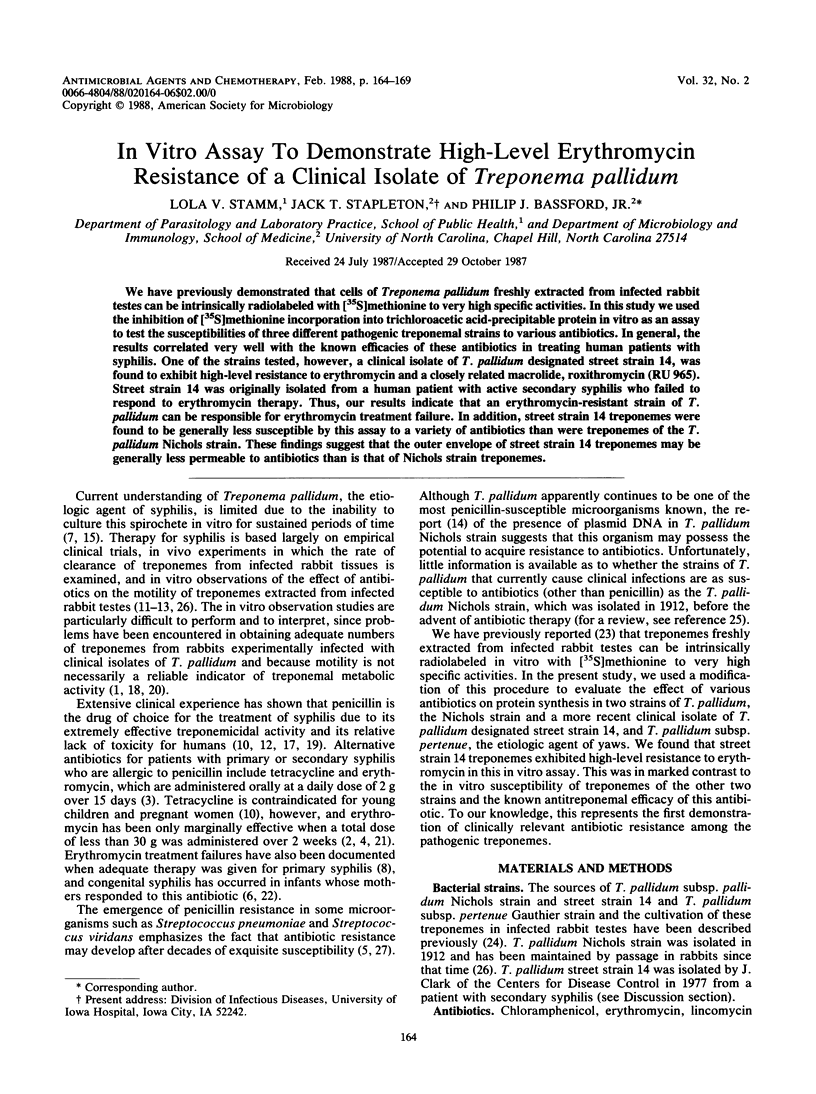
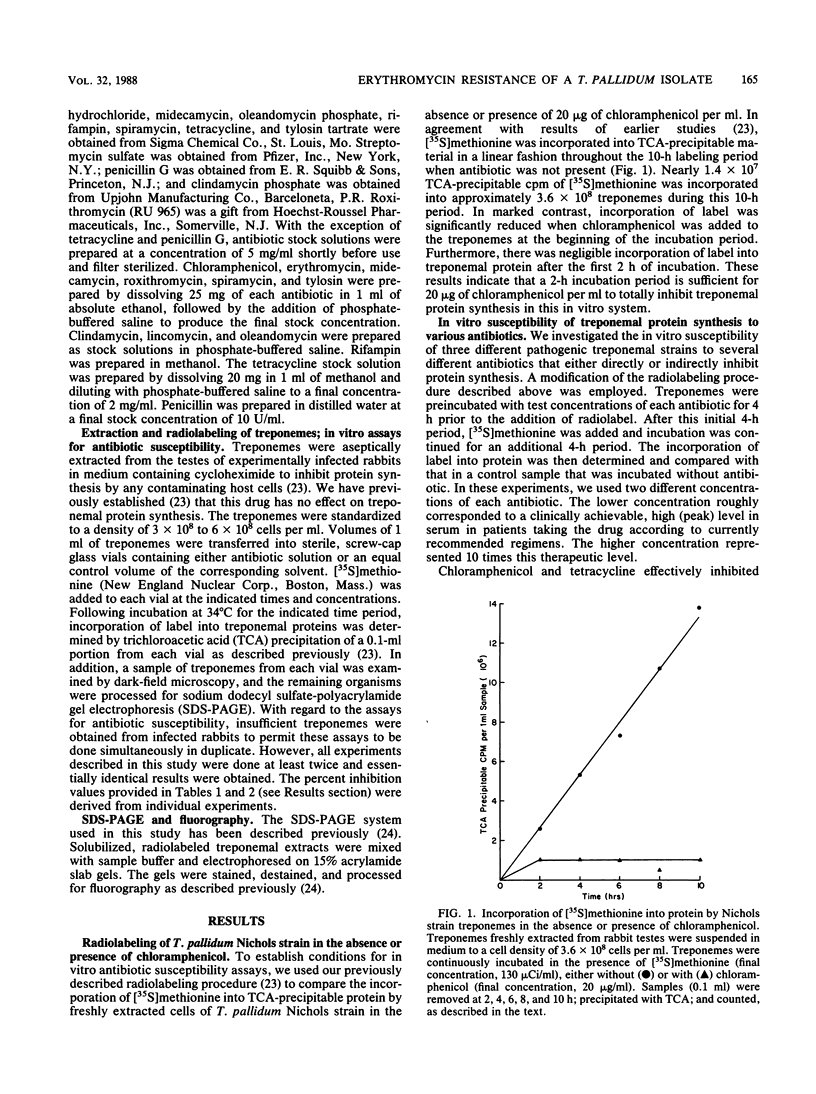
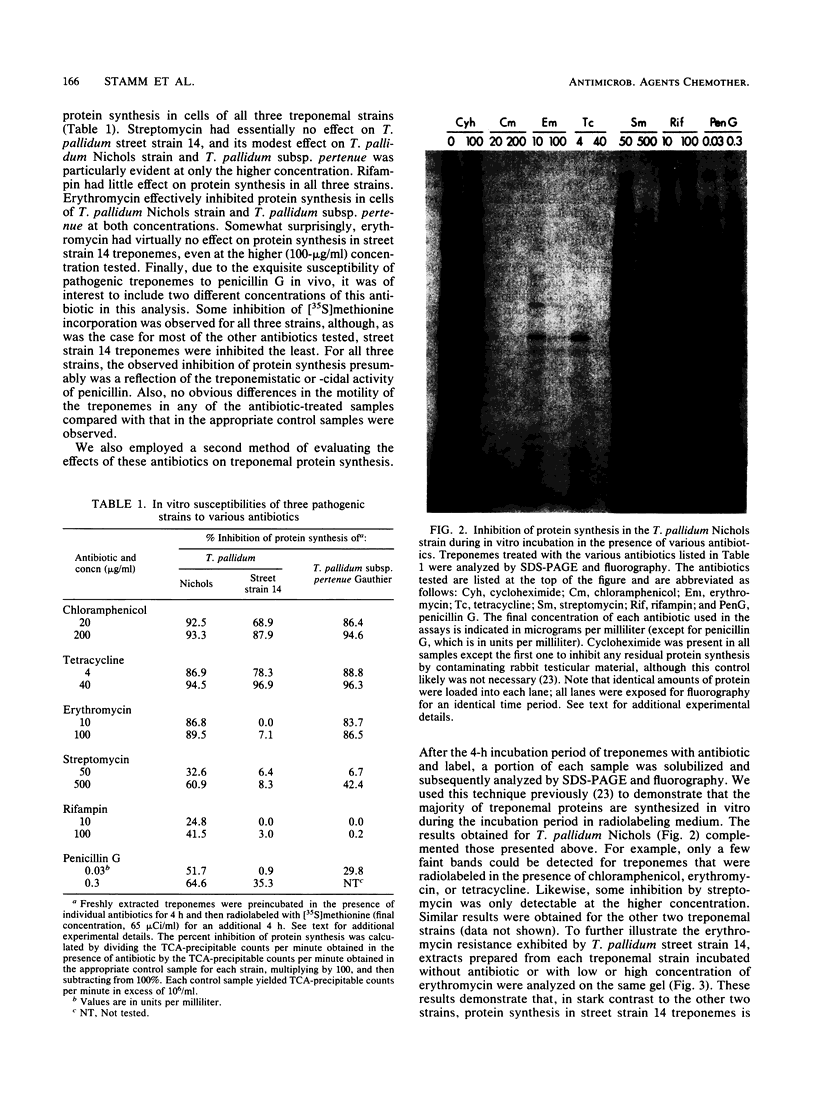
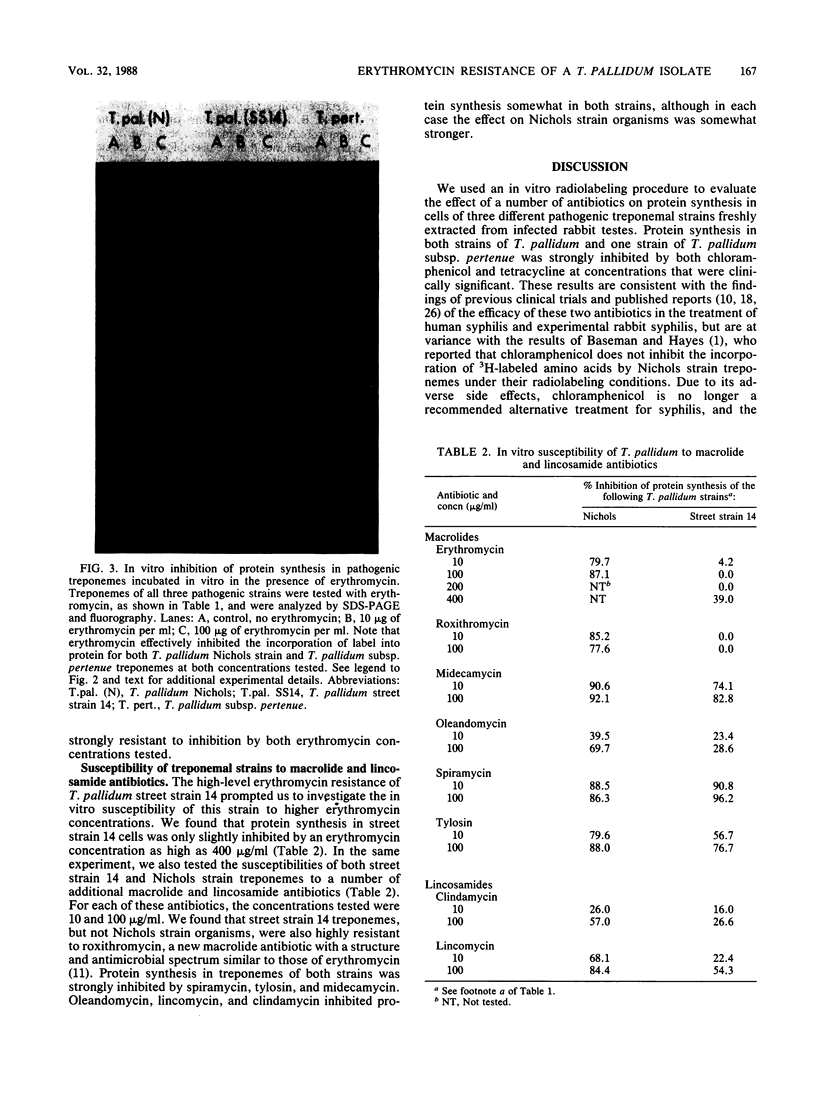
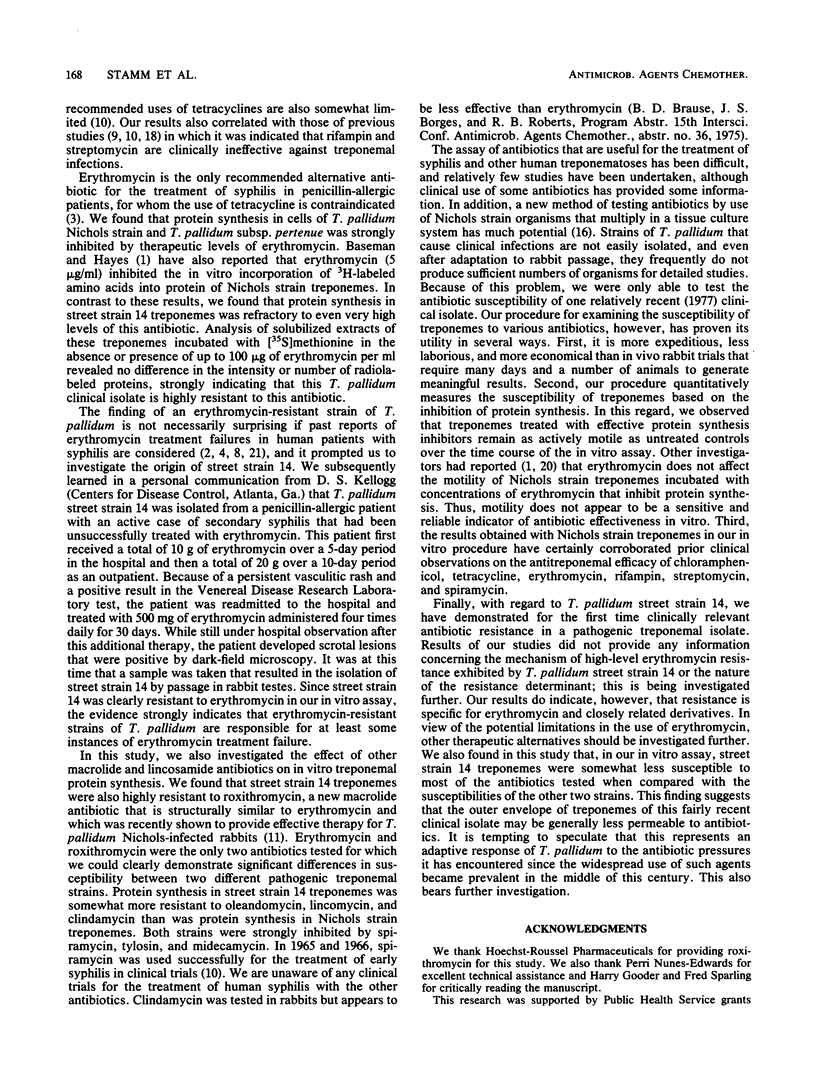
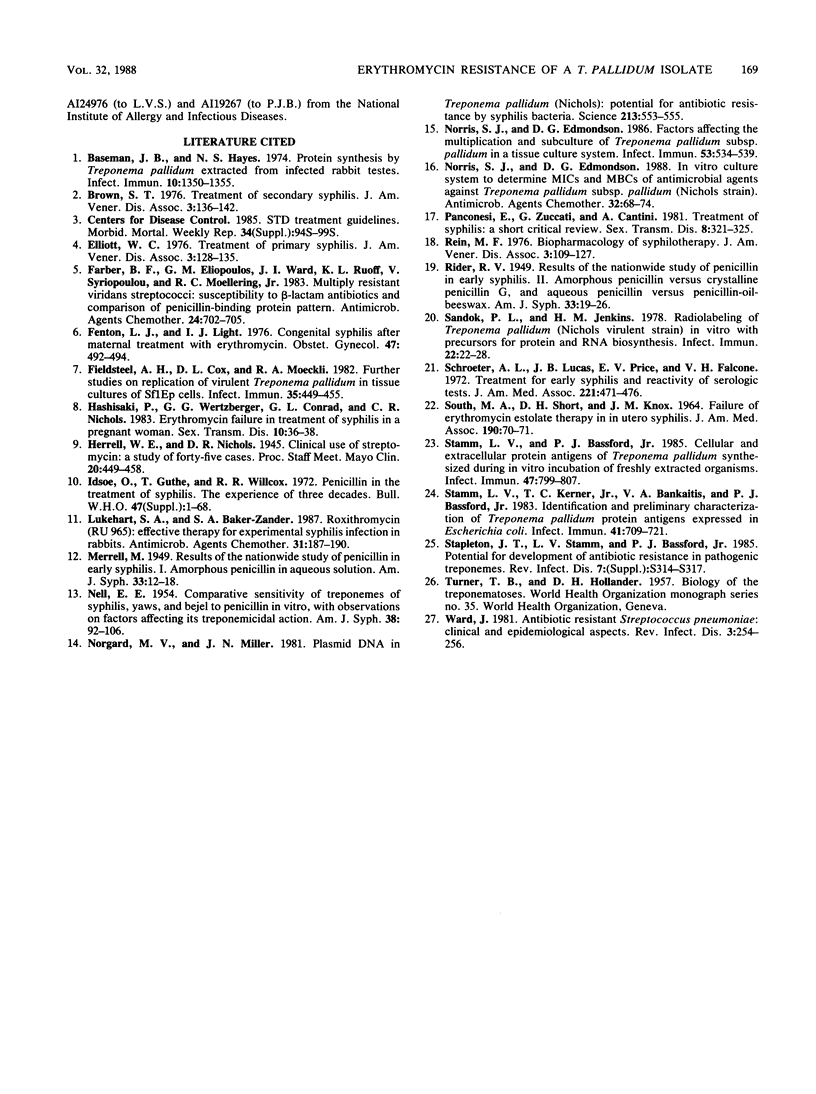
Images in this article
Selected References
These references are in PubMed. This may not be the complete list of references from this article.
- Baseman J. B., Hayes N. S. Protein synthesis by Treponema pallidum extracted from infected rabbit tissue. Infect Immun. 1974 Dec;10(6):1350–1355. doi: 10.1128/iai.10.6.1350-1355.1974. [DOI] [PMC free article] [PubMed] [Google Scholar]
- Brown S. T. Treatment of secondary syphilis. J Am Vener Dis Assoc. 1976 Dec;3(2 Pt 2):136–142. [PubMed] [Google Scholar]
- Elliott W. C. Treatment of primary syphilis. J Am Vener Dis Assoc. 1976 Dec;3(2 Pt 2):128–135. [PubMed] [Google Scholar]
- Farber B. F., Eliopoulos G. M., Ward J. I., Ruoff K. L., Syriopoulou V., Moellering R. C., Jr Multiply resistant viridans streptococci: susceptibility to beta-lactam antibiotics and comparison of penicillin-binding protein patterns. Antimicrob Agents Chemother. 1983 Nov;24(5):702–705. doi: 10.1128/aac.24.5.702. [DOI] [PMC free article] [PubMed] [Google Scholar]
- Fenton L. J., Light I. J. Congenital syphilis after maternal treatment with erythromycin. Obstet Gynecol. 1976 Apr;47(4):492–494. [PubMed] [Google Scholar]
- Fieldsteel A. H., Cox D. L., Moeckli R. A. Further studies on replication of virulent Treponema pallidum in tissue cultures of Sf1Ep cells. Infect Immun. 1982 Feb;35(2):449–455. doi: 10.1128/iai.35.2.449-455.1982. [DOI] [PMC free article] [PubMed] [Google Scholar]
- Hashisaki P., Wertzberger G. G., Conrad G. L., Nichols C. R. Erythromycin failure in the treatment of syphilis in a pregnant woman. Sex Transm Dis. 1983 Jan-Mar;10(1):36–38. doi: 10.1097/00007435-198301000-00008. [DOI] [PubMed] [Google Scholar]
- Idsoe O., Guthe T., Willcox R. R. Penicillin in the treatment of syphilis. The experience of three decades. Bull World Health Organ. 1972;47 (Suppl):1–68. [PMC free article] [PubMed] [Google Scholar]
- Lukehart S. A., Baker-Zander S. A. Roxithromycin (RU 965): effective therapy for experimental syphilis infection in rabbits. Antimicrob Agents Chemother. 1987 Feb;31(2):187–190. doi: 10.1128/aac.31.2.187. [DOI] [PMC free article] [PubMed] [Google Scholar]
- NELL E. E. Comparative sensitivity of treponemes of syphilis, yaws, and bejel to penicillin in vitro, with observations on factors affecting its treponemicidal action. Am J Syph Gonorrhea Vener Dis. 1954 Mar;38(2):92–106. [PubMed] [Google Scholar]
- Norgard M. V., Miller J. N. Plasmid DNA in Treponema pallidum (Nichols): potential for antibiotic resistance by syphilis bacteria. Science. 1981 Jul 31;213(4507):553–555. doi: 10.1126/science.6264606. [DOI] [PubMed] [Google Scholar]
- Norris S. J., Edmondson D. G. Factors affecting the multiplication and subculture of Treponema pallidum subsp. pallidum in a tissue culture system. Infect Immun. 1986 Sep;53(3):534–539. doi: 10.1128/iai.53.3.534-539.1986. [DOI] [PMC free article] [PubMed] [Google Scholar]
- Norris S. J., Edmondson D. G. In vitro culture system to determine MICs and MBCs of antimicrobial agents against Treponema pallidum subsp. pallidum (Nichols strain). Antimicrob Agents Chemother. 1988 Jan;32(1):68–74. doi: 10.1128/aac.32.1.68. [DOI] [PMC free article] [PubMed] [Google Scholar]
- Panconesi E., Zuccati G., Cantini A. Treatment of syphilis: a short critical review. Sex Transm Dis. 1981 Oct-Dec;8(4 Suppl):321–325. [PubMed] [Google Scholar]
- Rein M. F. Biopharmacology of syphilotherapy. J Am Vener Dis Assoc. 1976 Dec;3(2 Pt 2):109–127. [PubMed] [Google Scholar]
- SOUTH M. A., SHORT D. H., KNOX J. M. FAILURE OF ERYTHROMYCIN ESTOLATE THERAPY IN IN UTERO SYPHILIS. JAMA. 1964 Oct 5;190:70–71. doi: 10.1001/jama.1964.03070140076020. [DOI] [PubMed] [Google Scholar]
- Sandok P. L., Jenkin H. M. Radiolabeling of Treponema pallidum (Nichols virulent strain) in vitro with precursors for protein and RNA biosynthesis. Infect Immun. 1978 Oct;22(1):22–28. doi: 10.1128/iai.22.1.22-28.1978. [DOI] [PMC free article] [PubMed] [Google Scholar]
- Schroeter A. L., Lucas J. B., Price E. V., Falcone V. H. Treatment for early syphilis and reactivity of serologic tests. JAMA. 1972 Jul 31;221(5):471–476. [PubMed] [Google Scholar]
- Stamm L. V., Bassford P. J., Jr Cellular and extracellular protein antigens of Treponema pallidum synthesized during in vitro incubation of freshly extracted organisms. Infect Immun. 1985 Mar;47(3):799–807. doi: 10.1128/iai.47.3.799-807.1985. [DOI] [PMC free article] [PubMed] [Google Scholar]
- Stamm L. V., Kerner T. C., Jr, Bankaitis V. A., Bassford P. J., Jr Identification and preliminary characterization of Treponema pallidum protein antigens expressed in Escherichia coli. Infect Immun. 1983 Aug;41(2):709–721. doi: 10.1128/iai.41.2.709-721.1983. [DOI] [PMC free article] [PubMed] [Google Scholar]
- Stapleton J. T., Stamm L. V., Bassford P. J., Jr Potential for development of antibiotic resistance in pathogenic treponemes. Rev Infect Dis. 1985 May-Jun;7 (Suppl 2):S314–S317. doi: 10.1093/clinids/7-supplement_2.s314. [DOI] [PubMed] [Google Scholar]
- Ward J. Antibiotic-resistant Streptococcus pneumoniae: clinical and epidemiologic aspects. Rev Infect Dis. 1981 Mar-Apr;3(2):254–266. doi: 10.1093/clinids/3.2.254. [DOI] [PubMed] [Google Scholar]



